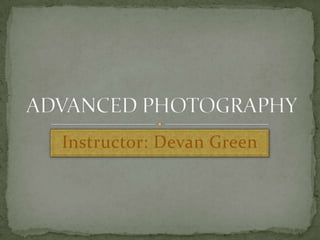Advanced photography
- 1. Instructor: Devan GreenADVANCED PHOTOGRAPHY
- 2. Technical components of a cameraApertureDepth of FieldShutter SpeedFramingLightingStatuary ∫›∫›fl£showToday you will learn
- 3. Also called aperture stop.Optics. An opening, usually circular, that limits the quantity of light that can enter an optical instrument. Aperture is measured in stops called f-stops. The number is actually the denominator of a fraction. So f-2 is ½ and f-8 is 1/8. When the lens is set to f2, the hole in the lens is 1/2 as big as the lens is long. When the lens is set to f8, the hole in the lens is 1/8th as big as the lens is long. Which hole is bigger, 1/2 or 1/8? The size of the stop is one factor that affects depth of fieldAperture
- 4. F-stopsSmaller stops (larger f numbers) produce a longer depth of field, allowing objects at a wide range of distances to all be in focus at the same time.
- 5. The aperture stop of a photographic lens can be adjusted to control the amount of light reaching the film or image sensor. In combination with variation of shutter speed, the aperture size will regulate the film's degree of exposure to light. Typically, a fast shutter speed will require a larger aperture to ensure sufficient light exposure, and a slow shutter speed will require a smaller aperture to avoid excessive exposure.Controlling light
- 6. the range of distances along the axis of a camera lens, through which an object will produce a relatively distinct image.In photography, the depth of field (DOF) is the portion of a scene that appears acceptably sharp in the image. Although a lens can precisely focus at only one distance, the decrease in sharpness is gradual on each side of the focused distance, so that within the DOF, the ambiguity is imperceptible under normal viewing conditions.Depth of Field
- 7. Level of FocusFor some images, such as landscapes, a large DOF may be appropriate, while for others, such as portraits, a small DOF may be more effective. In cinematography, a large DOF is often called deep focus, and a small DOF is often called shallow focus
- 8. For a given format size, except at close-up distances, DOF is approximately determined by the subject magnification and the lens f-number. For a given f-number, increasing the magnification, either by moving closer to the subject or using a lens of greater focal length, decreases the DOF; decreasing magnification increases DOF. For a given subject magnification, increasing the f-number (decreasing the aperture diameter) increases the DOF; decreasing f-number decreases DOFDOF
- 9. Shutter speeds control how long the lens lets the light in. The number is just the denominator of a fractionWhen the shutter speed is set to 125, light comes in for 1/125th of a second. When the shutter speed is set to 8, light comes in for 1/8th of a second. Which is longer, 1/125th or 1/8th? If you leave the water turned on for 1/8th of an hour (7.5 minutes), does more water flow than if you leave it turned on for 1/125th of an hour (less than 30 seconds Which shutter speed lets in more light, 1/8th or 1/125th? Shutter Speeds
- 10. Action StoppingShutter speeds also control the action-stopping ability of the camera. Moving subjects move farther the longer the shutter is open The more a subject moves during the exposure time (the length of time the shutter is open), the more the image of the subject moves across the film. The more the image moves across the film, the more blurred the image becomes. Short exposure times "freeze" action. Which shutter speed freezes action better, 1/8th or 1/500th?
- 11. A Sunny DayIt takes less time for just enough light to get to the film. High shutter speeds are more suitable for bright light. Longer shutter speeds are suitable for dim light
- 12. It is important to set-up your shots so that your subject is framed correctly. While you can be creative in your angles, there is a wrong way to frame a shot. You should not have too much lead room (the space in front of the subject), you also do not want to cut off the subject , you don’t want too much head room either (the space above the subject). You also don’t want your subject dead center (it can be boring). FRAMING
- 13. Examples of bad framing
- 14. Let there be LIGHT!Pay attention to your lighting scenario. Even if you must rely on natural light, make sure you have enough light for your shot. You may need to change position to get better light. You can also invest in lamps and umbrellas for interior shots. There are also reflectors that bounce sunlight.
- 15. The following is a presentation of a photographic study of the statuary in Detroit. Enjoy!Statuary Show
- 22. Questions?Thanks for attending Advanced Photography at the Pontiac Public Library.Look for the Winter 2010 Newsletter due out next month for future photography workshops here at your library.Have a Photographic & Happy Holiday Season!






















